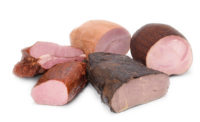In meat and poultry products, phosphate use as an ingredient is multifunctional. Phosphates most notably aid in water binding. In turn, phosphates can increase cook yields, which is valuable from an economic standpoint. Phosphates also raise the pH, which is part of their water-binding function, but additionally contribute to stabilizing the color of a product. Phosphates also have an antioxidant function, can contribute to antimicrobial protection and aid in protecting flavor changes over a slightly longer period of storage time.
Still, interest in removing phosphates from products continues because of the growth of natural and organic meat and poultry products, because phosphate does not quality for use in these products. While the natural and organic meat and poultry market makes up a small portion of total sales, a waterfall effect has occurred with processors’ interest in phosphate removal continuing to conventional products trying to clean up their labels, says Joseph Sebranek, Charles F. Curtiss Distinguished Professor in Agriculture and Life Sciences at Iowa State University in Ames.
In turn, a number of phosphate replacers and substitutes have entered the ingredient marketplace, and most of these substitutes address phosphate’s important water-binding function, Sebranek explains. For example, proteins, carrageenan, starches and other fibers all are offered to aid in binding in meat systems. “They wouldn’t necessarily include the other functions, and so that’s why they’re not, in my opinion, true phosphate replacers,” Sebranek says.
Edward Mills, associate professor of meat science at Penn State University, in University Park, Pa., says several interesting ingredients that at least do some of phosphate’s functions have emerged, and processors have been considering those. Additionally, it is possible for processors to get quite a bit of phosphate into a product in a natural form from dried fruit materials, Mills adds.
Studying Substitutes
While water binding may be the most important function phosphates provide, the plethora of phosphate replacers need close examination for several reasons including effects on the final product. For example, when protein is used as a water binder, processors now have to be concerned about allergens, Sebranek explains. Other phosphate substitutes have the adverse effect of diluting the color of products. Furthermore, phosphate replacements often don’t offer the same antioxidant impact, he says.
The bottom line is no one natural or organic phosphate substitute ingredient replaces all the functions of phosphate, Mills says. “Salesmen are pushing hard to get their products into companies and get companies to test their products, but it’s really important as you’re working with that salesman to nail down what functions are you able to accomplish and how are you accomplishing those in this particular material,” he says.
For example, not many choices for natural-category substitutes that would raise the pH of a meat product like phosphate are available. “Not everything, but anything that has high buffering capacity tends to be on the acid side,” Mills says. “So lowering the pH, it is easier to find natural ingredients that will lower the pH than it is to find those (that) raise it.”
Still, depending on the meat and poultry products, some of these adverse effects may not be important to the processor.
“The processor is going to have to do some homework to really determine whether these other kind of ingredients that really fit what they need for a particular product,” Sebranek says. “It’s difficult to replace the phosphates as far as the overall function is concerned, but just one function, then it’s a possibility, but you have to look carefully at the ingredients that might be used for that.”
Additionally, processors could examine the effective levels of phosphates they use in conventional products. “It may be possible to drop back to a lower concentration without losing any significant impact, and that’s a question each processor would have to look at for their individual products,” Sebranek says. “Most people are using something close to that half a percent, like maybe 0.4 percent in the formulations, and then may be dropping back a little bit is OK. It depends on what they want to accomplish with the given product.”
In addition to the advantageous functions phosphates offer, phosphates also are relatively cheap to use compared with phosphate substitutes.
“It gets to the situation where you give up some of the economic advantages that conventional products have when you go to natural and organic because of the restrictions on ingredients and so forth and the requirements for the meat ingredients that are involved with those products,” Sebranek says. “So the cost is now an issue, but it’s not as great an issue, in my opinion, with natural and organic products because consumers are going to pay more for those.”
In turn, while for nearly the past decade the industry has focused on replacing phosphates, in Sebranek’s opinion, this trend is slowing, and he believes phosphate usage in the industry will continue.
“Realizing that at least for products that are not natural or organic, phosphates are pretty darn important,” he says. NP











